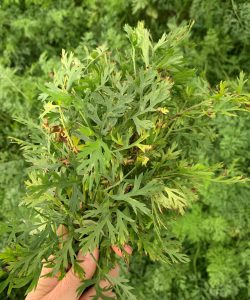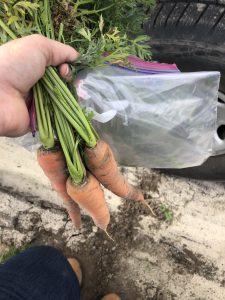Already in Suwannee County, growers have been reporting issues about dark spots on their carrot leaves or defoliation issues in their field. UF/IFAS Ag Extension Agents and Specialists have been visiting fields, taking samples, and sending them to the University of Florida Plant Diagnostic Lab for identification, where it was confirmed as Alternaria leaf blight. This fungal disease is usually found in the spring time in North Florida, but already this disease has been seen in some fields throughout the county since December. Read on to find out more about this fungal disease on carrots.

What is Alternaria Leaf Blight?
Alternaria leaf blight is caused by at least two species of Alternaria. It is most active from January to June in North Florida. It thrives in rainy wet conditions and in temperatures ranging from 60-77°F, basically what we see all spring in Florida. Alternaria is spread by spores, which can be moved by water splashing, the wind, or other mechanical means.
Identification:

Symptoms start as small black/brown leaf spots with water soaking on leaf foliage. As symptoms progress, leaves may show a yellow halo around the leaf spots and lesions may enlarge, merging together, causing large sections of leaves to show blighting. If a field has an advanced stage of the disease, there will be severe defoliation of older leaves within the lower canopy. Lesions in this stage may be elongated and may be dark brown or black.
Crop Damage:
Alternaria can cause major damage to a crop due to numerous leaf spots, yellowing, and defoliation of carrot leaves. The major concern is when symptoms begin to appear during active carrot production periods, mid to late season in Florida. The plants need increased photosynthetic activity during this growth stage period, but with increased defoliation, the carrot does not receive the nutrients it needs to fully grow. Also, from a harvesting standpoint, most mechanical harvesters require >50% of healthy carrot leaves for automatic harvesting. Unfortunately, Alternaria causes >50% leaf loss which limits harvesting capability.
 Cultural and Chemical Controls:
Cultural and Chemical Controls:
- Practice long rotations (3 to 4 years)
- Plant only pathogen-free seeds
- Select cultivars with resistance/tolerance
With Florida’s warm spring temperatures and prolonged periods of rain, Alternaria leaf blight is difficult to control. Fungicides are a primary control strategy and application may be required before symptoms develop. For proper management practices of Alternaria leaf blight, refer to the Vegetable Production Handbook of Florida for application information on products labeled for use on carrots here.
UF/IFAS Extension in Suwannee County is an Equal Opportunity Institution.
 0
0
